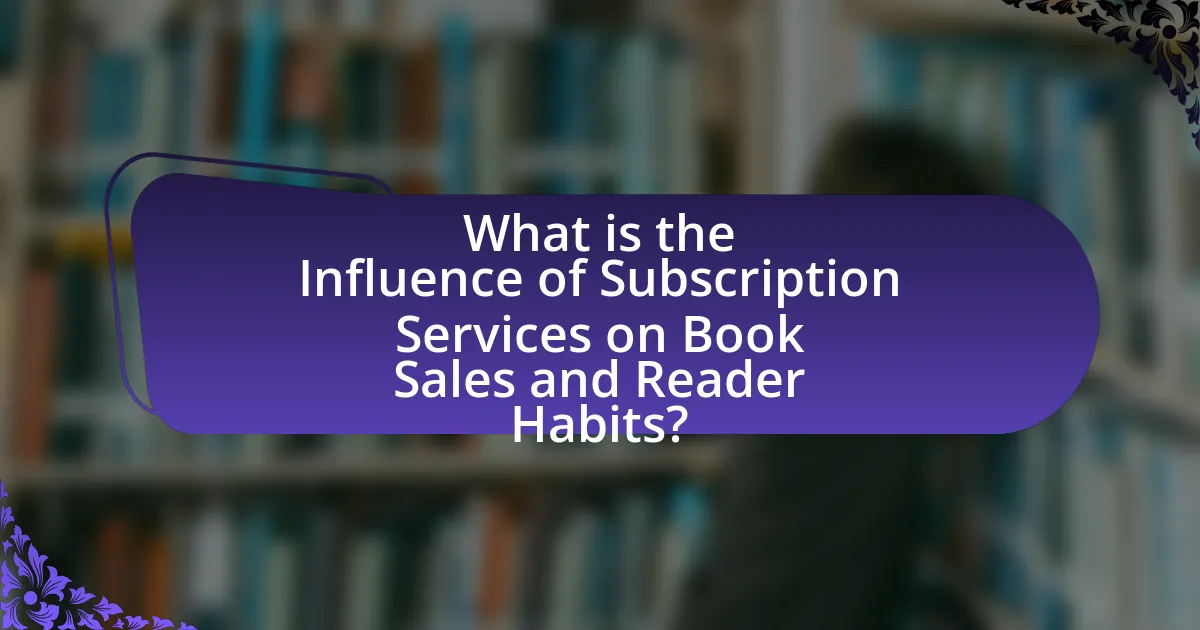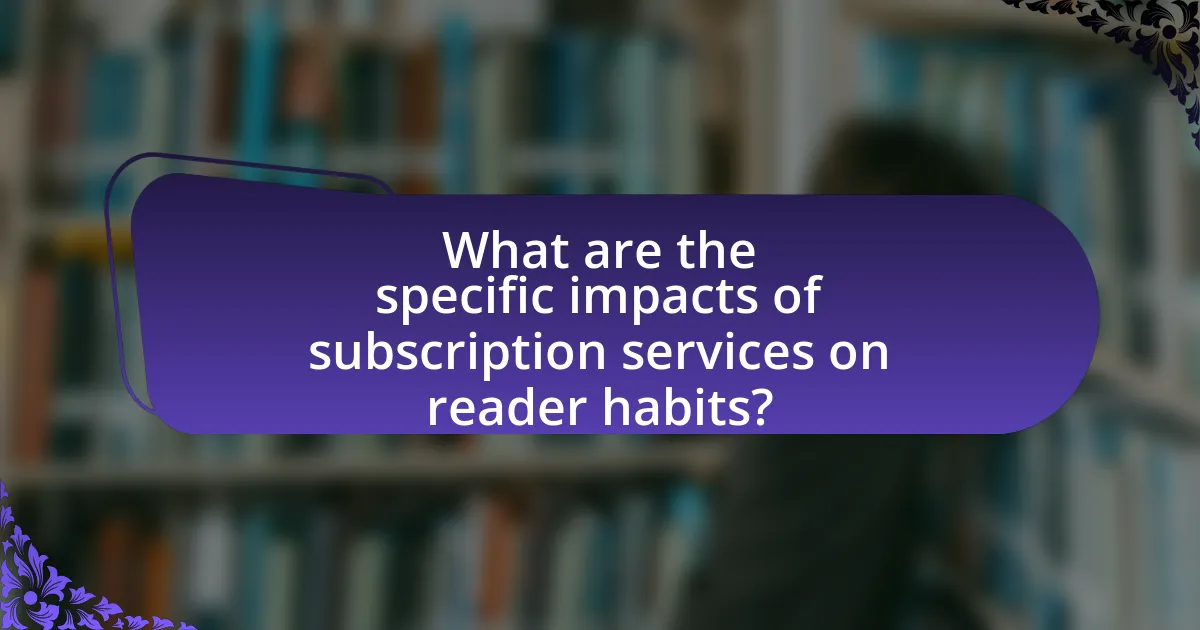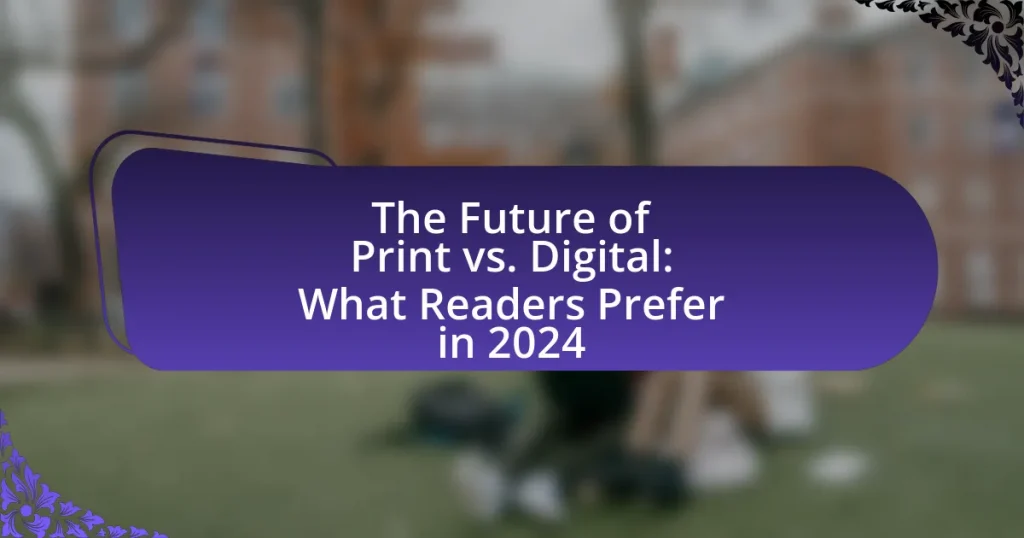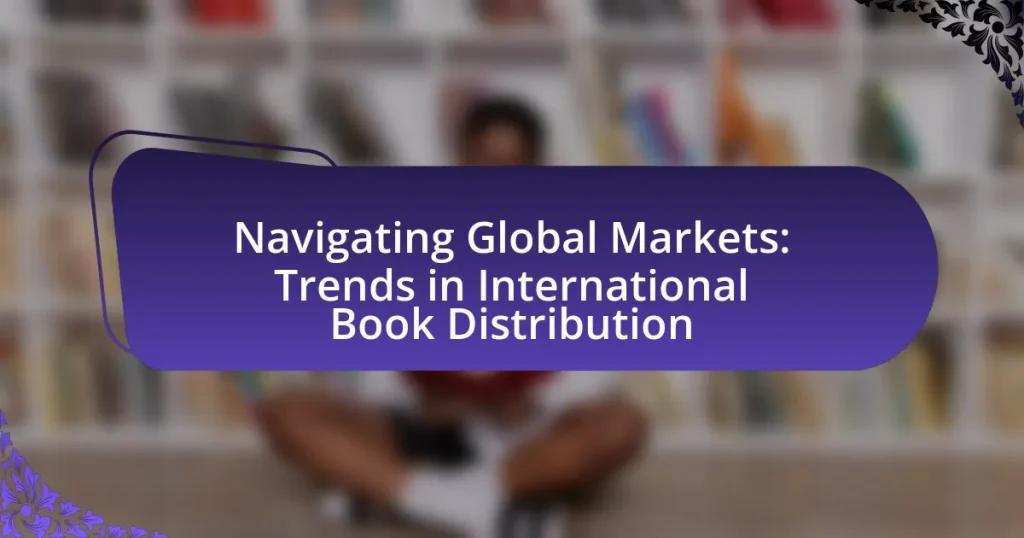The article examines the influence of subscription services on book sales and reader habits, highlighting how platforms like Kindle Unlimited and Audible enhance accessibility and promote diverse reading choices. It discusses the operational models of these services, their key features, and the emerging trends in book sales, including increased digital consumption and shifts in purchasing behaviors. Additionally, the article explores demographic changes among subscribers, the benefits perceived by readers, and the implications for the publishing industry, emphasizing the need for authors and publishers to adapt their strategies in response to this evolving landscape.

What is the Influence of Subscription Services on Book Sales and Reader Habits?
Subscription services significantly influence book sales and reader habits by increasing accessibility and encouraging diverse reading choices. These platforms, such as Kindle Unlimited and Audible, provide users with a vast library of titles for a flat monthly fee, which can lead to higher overall book consumption. According to a 2021 report by the Association of American Publishers, subscription services contributed to a 20% increase in eBook sales, indicating that readers are more likely to explore genres and authors they might not have purchased outright. Additionally, a survey by BookNet Canada revealed that 60% of subscribers to these services reported reading more books than before they joined, showcasing a shift in reader habits towards more frequent and varied reading experiences.
How do subscription services operate in the book industry?
Subscription services in the book industry operate by providing readers with access to a curated selection of books for a recurring fee. These services typically offer various plans that allow subscribers to read a certain number of books per month or access an entire library of titles. For instance, platforms like Audible and Scribd allow users to listen to audiobooks or read e-books, respectively, as part of their subscription.
The operational model often includes partnerships with publishers, enabling subscription services to offer a diverse range of titles while compensating authors and publishers through revenue-sharing agreements. According to a report by the Association of American Publishers, subscription services have contributed to a significant increase in digital book sales, indicating their growing influence on reader habits and preferences.
What are the key features of popular book subscription services?
Key features of popular book subscription services include a curated selection of books, flexible subscription plans, and access to exclusive content. Curated selections allow subscribers to discover new titles tailored to their preferences, enhancing the reading experience. Flexible plans, such as monthly or annual subscriptions, cater to different reading habits and budgets, making it accessible for a wider audience. Access to exclusive content, including author interviews, book discussions, and early releases, adds value and fosters a community among readers. These features collectively contribute to increased engagement and satisfaction among subscribers, influencing their reading habits and overall book sales.
How do these features impact user engagement?
Subscription services enhance user engagement by providing readers with easy access to a diverse range of books, which encourages exploration and discovery. This accessibility leads to increased reading frequency, as users are more likely to try new genres and authors without the financial commitment of purchasing each book. A study by the Pew Research Center found that 30% of e-book readers reported reading more books due to subscription services, indicating a direct correlation between these features and heightened engagement levels. Additionally, personalized recommendations within these platforms further stimulate user interaction, as they cater to individual preferences and reading habits, fostering a more immersive reading experience.
What trends are emerging in book sales due to subscription services?
Emerging trends in book sales due to subscription services include increased accessibility, a shift towards digital formats, and a rise in diverse reading habits. Subscription services like Kindle Unlimited and Audible have made a wide range of titles available to consumers for a flat monthly fee, leading to higher overall book consumption. According to a report by the Association of American Publishers, subscription services contributed to a 20% increase in eBook sales in 2022, indicating a significant shift towards digital reading. Additionally, these services often promote lesser-known authors and genres, fostering a more diverse literary landscape as readers explore beyond traditional bestsellers.
How have subscription services changed traditional book purchasing behaviors?
Subscription services have significantly altered traditional book purchasing behaviors by shifting consumer preferences from ownership to access. Readers now prioritize the ability to explore a wide range of titles for a fixed monthly fee, which contrasts with the previous model of purchasing individual books. For instance, services like Kindle Unlimited and Audible have reported millions of subscribers, indicating a strong market trend towards subscription-based reading. This model encourages readers to sample more genres and authors, leading to increased reading diversity and frequency. Additionally, a study by the Pew Research Center found that 20% of U.S. adults have used a subscription service for books, highlighting a notable shift in how books are consumed compared to traditional purchasing methods.
What demographic shifts are observed among subscribers?
Demographic shifts among subscribers indicate a growing diversity in age, gender, and geographic location. Recent studies show that younger readers, particularly those aged 18-34, are increasingly utilizing subscription services, with a reported 40% increase in this age group over the past five years. Additionally, female subscribers have risen to comprise approximately 60% of the total subscriber base, reflecting a shift in engagement levels. Geographic data reveals that urban areas are seeing a higher concentration of subscribers, with a 25% increase in metropolitan regions compared to rural areas. These trends highlight the evolving landscape of readership influenced by subscription services.
Why are readers increasingly turning to subscription services?
Readers are increasingly turning to subscription services due to the convenience and cost-effectiveness they offer. Subscription services provide access to a vast library of books for a fixed monthly fee, allowing readers to explore diverse genres without the financial burden of purchasing individual titles. According to a 2022 survey by the Pew Research Center, 30% of U.S. adults reported using a subscription service for books, highlighting a growing trend in reader preferences. This shift is further supported by the rise of platforms like Audible and Kindle Unlimited, which cater to the demand for instant access to literature and audiobooks, enhancing the overall reading experience.
What benefits do readers perceive in using subscription services?
Readers perceive several benefits in using subscription services, including access to a vast library of titles, cost savings, and convenience. Subscription services often provide unlimited access to a wide range of books for a fixed monthly fee, which can be more economical than purchasing individual titles. For example, services like Kindle Unlimited offer access to over a million titles, allowing readers to explore various genres without the financial burden of buying each book. Additionally, the convenience of accessing books on multiple devices enhances the reading experience, making it easier for readers to enjoy literature anytime and anywhere.
How do subscription services cater to diverse reading preferences?
Subscription services cater to diverse reading preferences by offering a wide range of genres, personalized recommendations, and curated collections. These platforms utilize algorithms that analyze user behavior and preferences to suggest books that align with individual tastes, ensuring that readers discover content that resonates with them. For instance, services like Kindle Unlimited and Scribd provide access to thousands of titles across various genres, from fiction to non-fiction, catering to niche interests and mainstream tastes alike. Additionally, subscription services often feature user reviews and ratings, which help readers make informed choices based on community feedback, further enhancing the personalization of their reading experience.
How do subscription services affect the overall book market?
Subscription services significantly impact the overall book market by increasing accessibility and altering consumer purchasing behavior. These services, such as Kindle Unlimited and Audible, provide readers with a vast selection of titles for a flat monthly fee, which encourages exploration of new genres and authors. According to a 2021 report by the Association of American Publishers, subscription services contributed to a 20% increase in eBook sales, demonstrating their role in expanding readership. Additionally, these platforms often promote lesser-known authors, thereby diversifying the market and challenging traditional sales models. This shift in consumer habits indicates that subscription services are reshaping how books are consumed and purchased, ultimately influencing the dynamics of the publishing industry.
What challenges do traditional bookstores face due to subscription services?
Traditional bookstores face significant challenges due to subscription services, primarily in terms of revenue loss and customer loyalty. Subscription services, such as Kindle Unlimited and Audible, offer consumers access to vast libraries of books for a flat monthly fee, which diminishes the incentive for customers to purchase individual titles from traditional bookstores. According to a 2021 report by the American Booksellers Association, independent bookstores experienced a decline in sales as more readers opted for subscription models that provide convenience and cost savings. Additionally, these services often prioritize digital formats, further marginalizing physical bookstores that rely on print sales. The shift in consumer behavior towards subscription models has led to increased competition, making it difficult for traditional bookstores to maintain their market share and profitability.

What are the specific impacts of subscription services on reader habits?
Subscription services significantly alter reader habits by increasing access to a wider range of reading materials and promoting diverse genres. These services, such as Kindle Unlimited and Audible, allow readers to explore books they might not have purchased outright, leading to a broader reading experience. A study by the Pew Research Center found that 27% of Americans reported using a subscription service for books, which correlates with an increase in overall reading frequency. Additionally, subscription models encourage binge-reading behaviors, as users often consume multiple titles in a short period due to the low cost per book. This shift in consumption patterns highlights how subscription services can reshape preferences and expand literary exploration among readers.
How do subscription services influence reading frequency and choices?
Subscription services significantly increase reading frequency and diversify reading choices. These services provide unlimited access to a vast library of books, encouraging readers to explore genres and authors they might not have considered otherwise. Research indicates that users of platforms like Kindle Unlimited or Audible read more frequently, with a study showing that subscribers read 30% more books annually compared to non-subscribers. Additionally, the ease of access and the low financial barrier associated with subscription models promote a habit of reading, leading to a broader range of literary exploration and consumption.
What changes in reading habits have been reported by subscribers?
Subscribers have reported an increase in digital reading and a preference for shorter content formats. This shift is attributed to the convenience of accessing a wide range of materials through subscription services, which has led to a decline in traditional print reading. According to a survey conducted by the Pew Research Center, 30% of subscribers indicated they read more e-books than before subscribing, highlighting a significant change in their reading habits. Additionally, the rise of audiobooks has contributed to this trend, with 20% of respondents stating they listen to more audiobooks since subscribing, further illustrating the evolving landscape of reader preferences.
How do subscription services affect the discovery of new authors and genres?
Subscription services significantly enhance the discovery of new authors and genres by providing readers with access to a diverse range of titles without the financial risk of purchasing each book. These platforms often use algorithms to recommend books based on user preferences, which can introduce readers to authors and genres they might not have explored otherwise. For instance, a study by the Pew Research Center found that 30% of e-book readers reported discovering new authors through subscription services, highlighting their role in expanding reader horizons. Additionally, subscription models often feature curated lists and themed collections, further promoting lesser-known authors and niche genres, thereby fostering a more inclusive literary landscape.
What role does technology play in shaping reader experiences with subscription services?
Technology significantly enhances reader experiences with subscription services by providing personalized content delivery and seamless access to a vast library of materials. For instance, algorithms analyze user preferences and reading habits, enabling services like Kindle Unlimited and Scribd to recommend titles that align with individual tastes. This personalization increases user engagement and satisfaction, as evidenced by a 2021 survey from the Pew Research Center, which found that 61% of users appreciated tailored recommendations. Additionally, technology facilitates instant access to books and audiobooks across multiple devices, allowing readers to enjoy content anytime and anywhere, further enriching their experience.
How do mobile apps enhance the usability of subscription services?
Mobile apps enhance the usability of subscription services by providing a user-friendly interface that facilitates easy access to content and features. These applications streamline the subscription process, allowing users to manage their accounts, browse offerings, and consume content seamlessly. For instance, a study by Statista in 2023 indicated that 70% of users prefer mobile apps for subscription management due to their convenience and efficiency. Additionally, mobile apps often incorporate personalized recommendations and notifications, which further improve user engagement and satisfaction.
What technological innovations are driving the growth of subscription services?
Technological innovations driving the growth of subscription services include cloud computing, mobile applications, and data analytics. Cloud computing enables scalable storage and access to content, allowing subscription services to offer vast libraries without significant upfront costs. Mobile applications enhance user experience by providing easy access to services on-the-go, increasing user engagement and retention. Data analytics allows companies to personalize offerings based on user behavior, leading to higher satisfaction and subscription rates. For instance, Netflix utilizes data analytics to recommend content, which has contributed to its substantial subscriber growth, reaching over 230 million subscribers by 2023.

What are the future implications of subscription services on the book industry?
Subscription services are likely to reshape the book industry by increasing accessibility and altering consumer purchasing behavior. As platforms like Kindle Unlimited and Audible gain popularity, they provide readers with a vast library of titles for a fixed monthly fee, which can lead to a decline in individual book sales. A report from the Association of American Publishers indicates that e-book sales have plateaued, suggesting that subscription models may be capturing a significant portion of the market. Furthermore, these services encourage readers to explore genres and authors they might not have considered otherwise, potentially diversifying readership and influencing publishing trends. The shift towards subscription models may also pressure traditional publishers to adapt their pricing strategies and marketing approaches to remain competitive in a changing landscape.
How might subscription services evolve in the coming years?
Subscription services are likely to evolve by incorporating more personalized content delivery and flexible pricing models. As consumer preferences shift towards tailored experiences, services may utilize advanced algorithms and AI to curate book selections based on individual reading habits and preferences. Additionally, the rise of tiered subscription plans could allow users to choose from various levels of access, enhancing user engagement and satisfaction. According to a report by Statista, the global subscription e-commerce market is projected to reach $478.2 billion by 2025, indicating a significant trend towards subscription-based models across various industries, including literature. This evolution will likely influence book sales and reader habits by making literature more accessible and fostering a culture of continuous reading.
What potential new features could enhance user experience?
Potential new features that could enhance user experience in subscription services for books include personalized reading recommendations based on user preferences and reading history. This feature can utilize machine learning algorithms to analyze user behavior and suggest titles that align with individual tastes, thereby increasing engagement and satisfaction. Research indicates that personalized recommendations can lead to a 20% increase in user retention rates, as users are more likely to continue using a service that consistently meets their interests. Additionally, integrating social features, such as book clubs or discussion forums, can foster community engagement, allowing users to share insights and recommendations, which has been shown to enhance the overall reading experience.
How might subscription services influence the publishing industry?
Subscription services significantly influence the publishing industry by altering revenue models and reader engagement. These services, such as Kindle Unlimited and Scribd, provide readers with access to a vast library of books for a monthly fee, which can lead to increased readership and exposure for authors. According to a 2021 report by the Association of American Publishers, subscription services accounted for approximately 10% of total book sales, indicating a growing trend in consumer preferences. Additionally, these platforms often prioritize data-driven recommendations, which can shape publishing trends and influence which genres or authors gain popularity. This shift towards subscription models encourages publishers to adapt their strategies, focusing on volume and accessibility rather than traditional sales metrics.
What strategies can authors and publishers adopt to leverage subscription services?
Authors and publishers can leverage subscription services by creating exclusive content and engaging with readers through personalized marketing. Exclusive content, such as serialized stories or behind-the-scenes material, can attract subscribers and enhance their reading experience. Personalized marketing, utilizing data analytics from subscription platforms, allows authors and publishers to tailor recommendations and promotions to individual reader preferences, increasing engagement and retention. According to a 2021 survey by the Book Industry Study Group, 45% of readers reported that they are more likely to read books from authors they discover through subscription services, highlighting the effectiveness of these strategies in reaching new audiences.
How can authors effectively market their work through subscription platforms?
Authors can effectively market their work through subscription platforms by leveraging targeted promotions, engaging with their audience, and utilizing analytics to refine their strategies. Targeted promotions, such as offering exclusive content or limited-time discounts, can attract subscribers and encourage them to explore an author’s work. Engaging with the audience through newsletters, social media, and interactive content fosters a community around the author’s brand, increasing visibility and loyalty. Additionally, utilizing analytics provided by subscription platforms helps authors understand reader preferences and behaviors, allowing them to tailor their marketing efforts effectively. For instance, a study by the Pew Research Center indicates that personalized recommendations significantly enhance user engagement on subscription services, demonstrating the importance of data-driven marketing strategies.
What best practices should publishers follow to maximize their reach via subscription services?
To maximize their reach via subscription services, publishers should implement targeted marketing strategies, optimize content for discoverability, and engage with their audience effectively. Targeted marketing strategies involve analyzing subscriber demographics and preferences to tailor promotions and recommendations, which can increase engagement and retention. Optimizing content for discoverability includes using relevant keywords and metadata to enhance visibility on subscription platforms, as studies show that improved searchability can lead to higher readership. Engaging with the audience through personalized communication and feedback mechanisms fosters a sense of community and loyalty, which is crucial for sustaining subscription growth.



